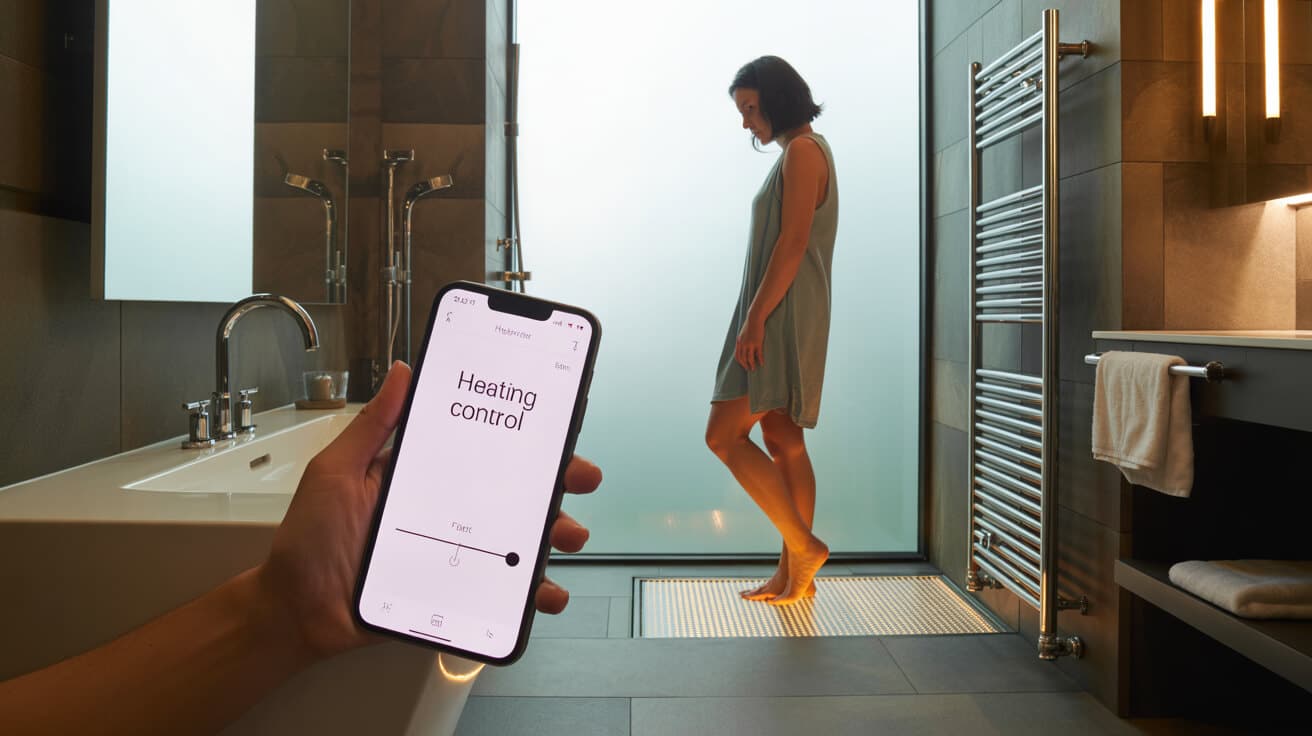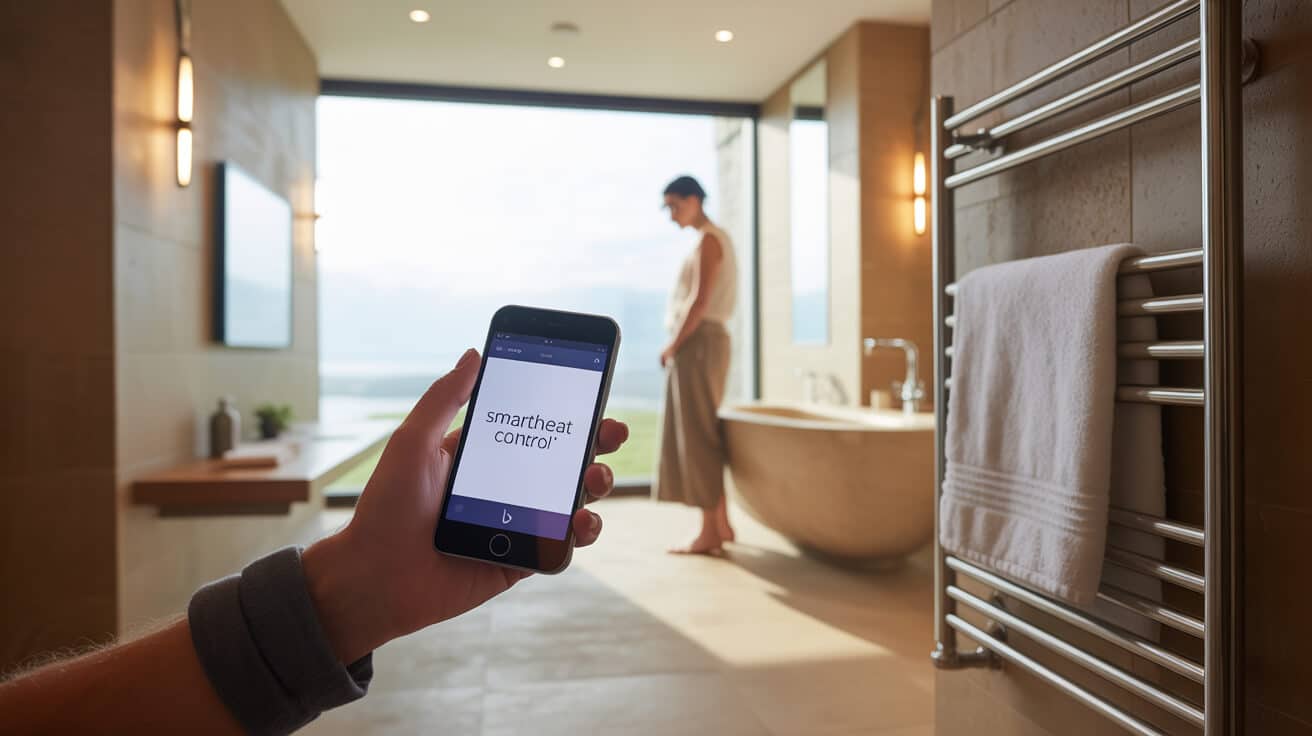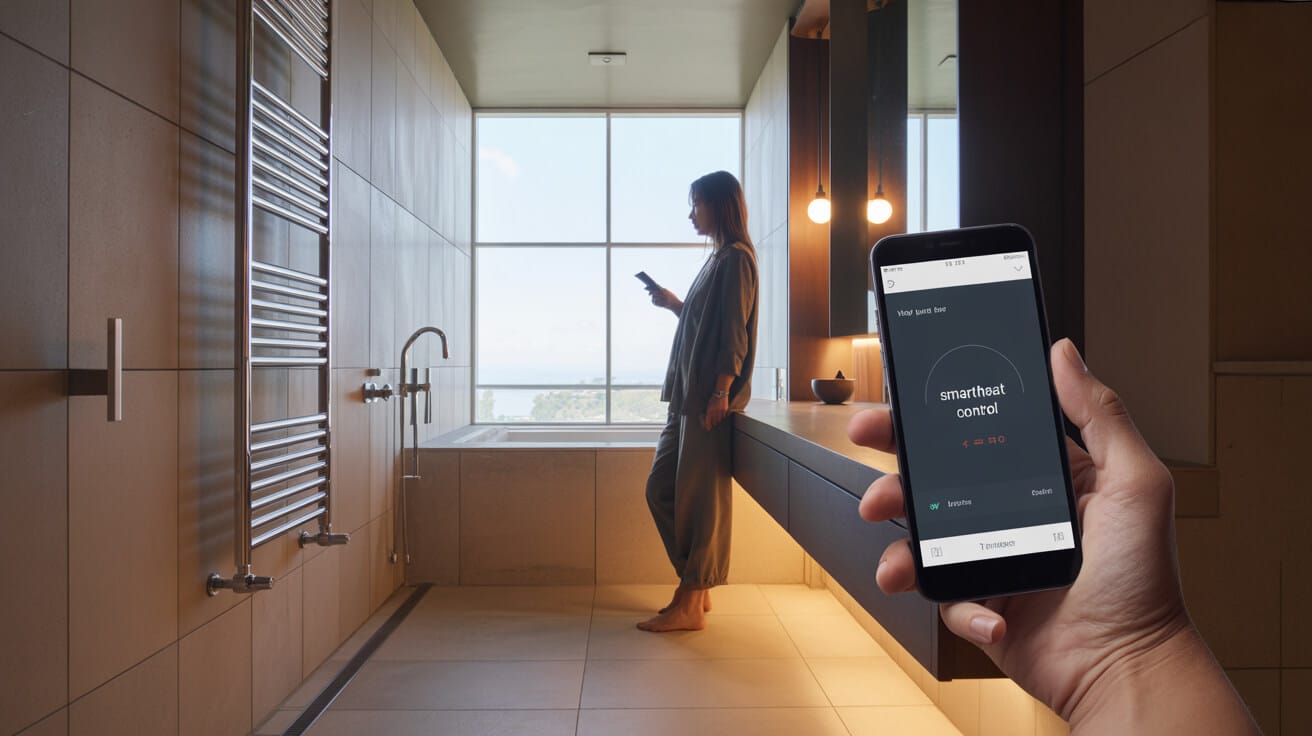Smartphone-enabled controls have redefined traditional heating management by allowing direct interaction with central heating, water circuits, and zoned temperature systems through application-driven software and wireless hardware. By extending the reach of users beyond static, location-dependent controls, these systems deliver tailored heating schedules, on-demand adaptation, and continuous access to system analytics. Services offered by Plumbers 4U and other qualified providers allow for both professional installation and long-term support, ensuring your property, whether residential or commercial, benefits from up-to-date, efficient, and compliant heating control.
Etymology or Name Origin
The concept combines the modern mobile “smartphone”—a handheld device offering advanced connectivity and programmable functions—with “controlled heating,” referring to user-guided management of indoor climate systems. The nomenclature gained currency with the emergence of application-based thermostats in the 2010s, reflecting a shift from simple programmable timers and thermostats towards interactive, internet-connected devices. Earlier terminology, such as “digital thermostat” and “remote heating controller,” underscores the evolution from zone-specific, mechanical, or dial-based models to holistic, property-wide platforms.
Overview and Context
Smartphone-based heating control represents a convergence of advances in digital communications, building services, and user-centred design, bringing the roles of heating engineers, plumbers, facilities managers, and IT experts into alignment. These systems operate through wireless networks, interfacing with boilers, radiators, underfloor heating, and hot water storage, while presenting intuitive interfaces for users on mobile devices. They are available for single-zone instals in small homes and for multi-zone and multi-property portfolios in landlord and commercial contexts. Plumbing and heating firms play a substantial part not only in installation and technical integration but also in supporting property owners and managers through consultation, upgrades, and compliance service.
Definition and Scope
Smartphone controlled heating systems allow for continuous or scheduled adjustment of environmental settings through secure cloud-based or local area protocols. The technology’s application context encompasses residential dwellings, managed rental portfolios, commercial offices, and large institutional properties in which efficiency, comfort, and regulatory compliance are primary drivers.
Functional Scope
- Real-time and scheduled temperature adjustments remotely
- User analytics and trend monitoring
- Flexible multi-user roles and permissions (landlord, tenant, property manager)
- System integration for new-builds and legacy heating infrastructure
Cross-disciplinary Role
- Plumbing and heating professionals ensure compatibility and safe integration
- Digital service providers enable secure, user-driven interfaces
- Regulatory bodies stipulate standards for installation, maintenance, and security
History
Origins
Manual heating control was dominant in domestic and commercial contexts until advances in electrical engineering allowed for the introduction of thermostatic control valves and time switches in the late twentieth century. Early forms of automation provided limited flexibility, restricted to basic schedules or local override using physical controls.
Industrial Emergence
By the early 2000s, larger-scale building management systems employed distributed control and web-based dashboards, primarily for the commercial sector. Adoption in the residential market accelerated as wireless technologies and consumer-grade programmable thermostats became more widely available. The first mobile-compatible systems relied on radio frequency or proprietary wireless connections with limited interoperability and inconsistent support for complex heating configurations.
Contemporary Evolution
The proliferation of smartphones and standardised wireless protocols in the 2010s catalysed a shift to app-enabled controllers. Multiple manufacturers began to market systems that interfaced directly with a user’s phone, supporting both self-installation and professionally accredited integration. Companies like Plumbers 4U facilitate installation and support, responding to consumer demand for interoperability, security, ease of use and regulatory compliance. The industry has trended toward user-centric design, automatic learning, seamless upgrades, and enhanced security protocols, with the UK government and professional bodies issuing updated guidance on acceptable practices.

Concept and Description
System Architecture and Layers
Comprehensive smartphone heating systems are comprised of:
- Central smart thermostats: Interface between the user and the heating system, receiving and digitising input from user devices.
- Electronic actuators and relays: Manage mechanical switching of boilers, valves, and circuits in accordance with programmed directives.
- Sensor networks: Monitor temperature, humidity, and presence for closed-loop feedback control.
- App-based interfaces: Enable user-side configuration, schedule management, real-time control, and system error notification.
- Cloud or local server modules: Store user preferences and facilitate remote diagnostics, firmware updates, and compliance tracking.
Systems can be deployed in both retrofit and new-build scenarios, requiring careful configuration to interface with existing heating system architectures. Redundant manual controls and physical overrides remain essential for safety and assurance during wireless outages or emergencies.
Operation Principles
After initial installation and setup, your heating system connects to a secure wireless network. Commands issued through a mobile application are encrypted and transmitted to the thermostat or relay, processed according to the programmed rules (such as daily schedules or temperature triggers), and executed directly by the hardware actuators. In buildings with zone heating or underfloor systems, networked valves or actuators can offer highly granular control of temperature and timing. Real-time environmental data from sensors support adaptive, data-driven optimization, which enables heated spaces to respond to shifting occupancy, weather patterns, or tariff changes.
User Interfaces
Mobile applications support multi-platform deployment (iOS, Android) and are designed for usability, clarity, and accessibility:
- Intuitive dashboards providing manual and scheduled adjustments
- Multi-zone navigation for managing different rooms, floors, or buildings
- Visualisation of live system states and temperature trends
- Alerts for system faults, service reminders, or compliance failures
- Integrated data privacy settings and multi-user permissions
Systems installed by Plumbers 4U prioritise compatibility with mainstream mobile devices, assuring seamless onboarding for new occupants.
Functionality, Purpose, and Applications
Practical Uses
Smartphone-controlled heating covers a wide array of use-cases:
- Simplifying comfort management, allowing individual control by occupants, tenants, or owners across multiple locations
- Supporting property managers through the aggregation of control functions, remote diagnostics, and compliance monitoring
- Facilitating responsive, granular adjustments in response to unpredictable schedules, reducing energy waste
Outcomes
Benefits include enhanced comfort, flexibility, convenience, and reduction in energy costs. Transparent access to heating usage analytics allows you to track, model, and respond to seasonal or behavioural trends, empowering both short-term adaptation and long-term strategy.
Deployment Domains
- Private homes: Targeted at those seeking energy saving, convenience, or increased property value.
- Rented properties: Landlords and letting agents can support tenants while centrally managing performance, safety, and cost.
- Commercial and institutional buildings: Multi-site control, integration with broader building services management, reporting, and compliance automation for organisations or facilities.
Classifications, Types, and Variants
System Typologies
The market presents two broad configurations:
- Single-zone systems: One thermostat, recommended for compact properties or straightforward upgrade paths.
- Multi-zone platforms: Physical or virtual division into distinct heating zones (by room, floor, or building segment) with networked, independent actuators and sensors.
Brand and Product Differentiation
Feature sets, compatibility, and installer support vary across major and niche suppliers. Tables comparing popular solution classes are common in the market:
| Brand | Zones Supported | Voice Control | OpenTherm | Rental Use | Updates |
|---|---|---|---|---|---|
| Nest | 1-2 | Yes | Yes | Partial | Auto OTA |
| Hive | Multi | Yes | No | Yes | Auto OTA |
| Tado | Multi | Yes | Yes | Yes | Auto OTA |
| Wiser | Multi | Yes | Yes | Yes | Auto OTA |
Feature Sets
Systems now maturely offer:
- Adaptive scheduling and dynamic learning algorithms
- Occupancy-driven energy management
- Support for underfloor heating, mixed fuel systems, and enhanced property types
- Automatic updates, over-the-air firmware upgrades, and advanced reporting
Systems, Tools, and Methodologies
Installation Process
Professional installations, such as those conducted by Plumbers 4U, follow a rigorous lifecycle:
- Site survey and compatibility assessment: Evaluate the property architecture, heating system topology, wireless signal quality, and necessary upgrades.
- System selection and procurement: Match client requirements with certified hardware from leading suppliers, considering communication protocol, regulatory obligations, and maintenance plans.
- Physical installation: Mount controllers, actuators, and sensors; replace legacy components as needed; ensure safe isolation and reconnection of utilities.
- Network and app configuration: Establish secure Wi-Fi or alternative connection, pair devices, configure user permissions, train occupants in system use.
- Commissioning and compliance: Undertake full operational tests, document all settings, and verify compliance with UK and EU regulations.
Engineer Roles
Maintenance and troubleshooting require:
- System diagnostics using specialised electronic equipment
- Firmware updates
- Remote monitoring and performance analytics
- Servicing of wireless modules and sensor arrays
- Training for occupants or client staff on best practices in control, data privacy, and energy planning
Tools and Equipment
Standardised tools include:
- Diagnostic testers for wireless communications and system health
- Valve service and replacement kits
- Secure tablets or laptops for configuration and analysis
- Manufacturer-certified software for system update and validation

Stakeholders and Entities Involved
End Users
Homeowners benefit from increased control and energy insights, while your tenants enjoy convenience and comfort. Landlords, letting agents, and facilities managers gain a remote overview of system status, predictive servicing, and compliance assurance.
Service Ecosystem
- Licenced plumbing and heating companies like Plumbers 4U handle compatibility assessment, integration, upgrade, aftercare, and compliance administration.
- Manufacturers and software developers deliver products, updates, and cloud infrastructure.
- Regulatory bodies verify the safety and efficacy of both components and processes.
Complementary Specialists
Electrical contractors, energy assessors, and digital security consultants often collaborate with installation teams to deliver comprehensive, future-proof solutions on larger projects.
Legal, Regulatory, and Ethical Considerations
Building and Installation Codes
Legal frameworks stipulate all installed systems adhere to:
- Energy performance standards, especially Building Regulations Part L (efficiency), Part G (hot water and safety), and Boiler Plus (intelligent control as a minimum standard)
- Compliance with manufacturer protocols, safety certifications, and product marking (e.g., WRAS certification, UKCA, CE)
Product and Installer Standards
Installers must hold certification that assures proper commissioning, setting, and client onboarding. All system documentation should be managed and demonstrated for audit, warranty, and inspection purposes.
Data Protection and Cybersecurity
Systems which retain or transmit personal data (schedules, temperatures, user IDs) must comply with GDPR. Robust design—end-to-end encryption, strong user authentication, regular security patching—is now standard. Provider support includes offering best-practice advice and implementing default-strong privacy settings.
Incentives and Compliance Programmes
Government incentives, including the Boiler Upgrade Scheme (BUS), Energy Company Obligation (ECO4), and local council initiatives, are available for qualifying heating system upgrades. Certified providers support your application and compliance processes, maximising your eligibility and successful claim outcomes.
Performance Metrics and Impact
Energy and Cost Efficiency
Adaptive, granular management underpins heating cost reduction over annual cycles. User and building studies show a measurable reduction in consumption for properties using app-controlled, zoned, or occupancy-responsive heating, particularly when combined with insulated building fabric and efficient plant.
Usability and Occupant Experience
Feedback points to improvements in system accessibility, multi-user control, and digital inclusion. Landlords cite positive tenant uptake and fewer service complaints. Facilities managers appreciate integration with reporting and analytics, enhancing budget forecasting and performance benchmarking.
Service and Maintenance Outcomes
Proactive service reminders, automatic alerts, remote diagnostic capability, and error code reporting allow companies like Plumbers 4U to deliver prompt, targeted aftercare. This minimises downtime, reduces unnecessary engineer callouts, and empowers property managers to maintain compliant, high-performing heating systems.
Challenges, Barriers, and Limitations
Technical Compatibility and Operational Barriers
Older building stock and legacy systems may lack the infrastructure to fully support wireless or networked modules, necessitating costly retrofits or hybrid solutions. Signal interference, problematic router locations, and firmware incompatibilities present recurring challenges.
Economic and Social Factors
Cost concerns, technology aversion in some users, digital literacy gaps, and uncertainty over long-term support lead to reluctance in some sectors. Market adoption rates vary across age, property type, and regional demographics.
Maintenance and Reliability
Change in tenant or staff can disrupt user-permissions management, lead to lost access, or orphaned systems. Battery-powered sensors and wireless peripherals require regular, competent maintenance, while system updates demand network stability and administrator oversight.
Security and Privacy Risks
Vulnerabilities may be exploited if devices are not properly installed, passwords are weak, or software is outdated. Adherence to manufacturer bulletins, regular security checks, and prompt patching mitigate risks, but ultimate responsibility resides with both providers and end users.
Impact, Influence, and Legacy
Sector Transformation
Smartphone integration has become a baseline expectation among property buyers and renters, fundamentally altering the value proposition and required skills in plumbing and heating professions. Where traditional approaches favoured reactive maintenance, modern practice emphasises proactive, data-driven optimization.
Best Practices and Standardisation
Widespread adoption has led to new codes of conduct, industry training modules, and a refined process for verifying compliance and value alignment among companies, clients, and regulators alike. These ensure consistently high standards, driving industry trust and property performance.
Market and Policy Influence
Government net-zero agendas and consumer energy awareness have elevated app-based control to a legislative priority. Enhanced market competition, consumer choice, and property differentiation underscore the growing role of digital heating control in housing, rental, and commercial property governance.
Future directions, cultural relevance, and design discourse
Anticipated shifts include the integration of predictive and adaptive technologies utilising behavioural analytics, seasonal forecasting, and environmental data. Regulatory tightening is likely to require stronger baseline security, universal standards for system interoperability, and more nuanced privacy architectures. Design is moving toward inclusive, language-neutral interfaces, and cultural attitudes are steadily shifting toward the mainstream acceptance of digital oversight in both private and corporate settings. Demand for data transparency, support for remote working patterns, and multi-stakeholder access further inform the evolving contours of property heating management and service delivery.

